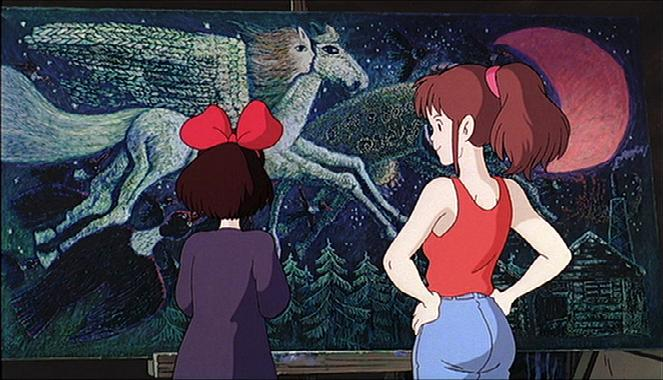KIKI’S DELIVERY SERVICE
Dir. Hayao Miyazaki
1989
Of all the Hayao Miyazaki classics, Kiki’s Delivery Service is the one where I hear criticism and find myself becoming defensive. My favorite, The Wind Rises, is a challenging film about a morally ambiguous, naive romantic – I have a hard time blaming people for bouncing off a film dwelling on World War II that finds the nature of war itself abominable. But with Kiki’s Delivery Service, I feel the frown start to set in as it slips down the rankings below Porco Rosso, Castle in the Sky, or Howl’s Moving Castle, which are all films I love.
I think it’s because Kiki feels central to Miyazaki’s protagonists. In his book Turning Point, Miyazaki describes Chihiro of Spirited Away as “a brat, frankly,” and the purpose of the film is watching her grow up. By the end of the film, Chihiro’s kindness, independence, and sense of empathy in her relationships comes close to where Kiki starts Kiki’s Delivery Service. In Kiki’s Delivery Service, we watch Kiki grow from a kind, independent, but naive and somewhat insecure girl into a self-motivated hero like the titular Nausicaa. These stories of maturation are intended to encourage those on the precipice between dependence and independence, and Miyazaki gives a bit of the game away that Kiki’s Delivery Service was partly made to encourage Studio Ghibli’s own younger staffers who were trying to find their place in adult society.
So we begin Kiki with her moving out from her parents’ home and moving to the city, getting a job, and finding fulfillment in that job. These are the rhythms Kiki has been taught how to do – to ply her trade, in a maybe unconventional way, and put down roots. She adores the old lady who makes artisan pies for her ungrateful granddaughter. She admires the artist who has achieved the self-motivation Kiki lacks. And the film’s primary drama arrives only when she experiences her first setbacks – she catches a mild pneumonia, and after she recovers, she becomes deeply depressed after an awkward social encounter with her friend Tombo.
The depressive episode, like the peril in My Neighbor Totoro, is unconventional for a children’s fantasy film. Both films explore the encroaching of real adult concerns in a direct and nonsymbolic way – I’d contrast with the extreme abstraction of The Boy and the Heron’s fantasy world or the slime Howl gag in Howl’s Moving Castle. Kiki’s depression means she can’t fly, that she can’t talk to her cat. The magic doesn’t create the drama – the magic disappearing creates the drama.

